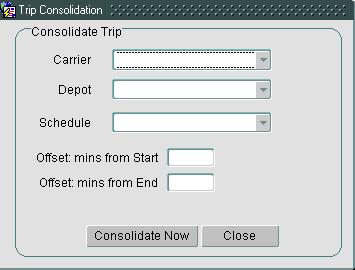Trip Consolidation
Trip Consolidation is responsible for automating the process of combining trips together to provide an improved use of resources (Trailers and Drivers). These Trips had not previously been combined due to constraints imposed in external scheduling tools.
The trips that are considered to be candidates for Trip Consolidation are deemed to be short trips (the maximum length of a ‘short’ trip is controlled by System Parameters). The Trips are also filtered on Schedule and Carrier parameters that are selected via the following form:

Once a set of trips has been identified Trip Consolidation will work its way through the trips and attempt to merge each trip with every other trip using the existing merge routines from the TRM package. The trips that can be created by the Consolidation routine are controlled by Maximum Trip Duration, Trip Threshold Duration and Trip Overlap Duration system parameters to ensure they are feasible. The Trip Validation routine from the TRM package is used to ensure that all merged trips are valid trips.
Each attempted merger and its associated ‘cost’ is recorded in memory but no changes are written to the database at this point, invalid trips will be discounted. Once each combination has been attempted a number of potential Consolidation options will exist. The option that provides the best solution (lowest ‘cost’) is then selected and applied to database.
The cost of a trip is calculated using a formula involving its duration (D), e.g. 10 hours, and three constants shown on the Resources screen (Carriers tab): Standard Shift (S), e.g. 9 hours, Standard Factor (s), e.g. 1, and Overtime Factor (t), e.g. 0,5. The cost of the Consolidation Option is therefore the sum cost of all the trips in that option.
The average start time for each option is also calculated. If two options have the same cost the option with the earliest average start time is selected, giving preference to the option that consolidates the early trips.